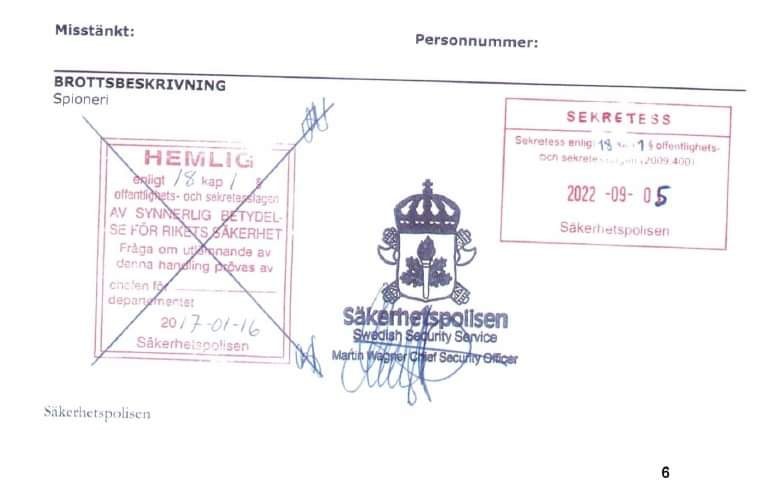1.0. Who are the Kia brothers?
The Kia brothers are guilty of what might evolve into one of the most significant cases of espionage in Swedish history.
The two brothers, Peyman and Payam Kia arrived in Sweden from Iran with their family in the 1990s. In 2007 the Swedish Security Service (SÄPO) employed the older brother, Peyman, after his completion of a trainee program [source]. He worked in the organisation between 2007-2011 and 2014-2015 [source]. According to Peyman, he served close to the core echelon of the organisation and was “chosen” to conduct counterintelligence operations on Swedish soil [source]. Furthermore, SÄPO reportedly employed his younger brother, Payam, although his exact role is unclear, as is when his employment took place [source].
SÄPO is rejecting the claims of Peyman’s role, who reportedly worked as a case manager with limited access to sensitive information. Also, the younger brother, Payam, reportedly never held employment at the organisation [source]. They instead charged Payam on suspicions of having worked as the link between Peyman and the Russian military intelligence service (GRU).
After his first employment at SÄPO, Peyman worked at the Swedish military intelligence service, MUST. It is currently unclear what position he had in the organisation. Overall, it is claimed to have been of a very sensitive nature.
In 2015, Peyman got a manager position at the Swedish Food Agency. For years, SÄPO suspected that there was a mole inside the organisation. Two years after Peyman’s employment at the Swedish Food Agency, in 2017, SÄPO, with the support of MUST and the Swedish national authority for Signals Intelligence (FRA), initiated the investigation into suspected espionage.
2.0. What has happened?

On November 11th, 2022, the government charged the brothers with what may be one of the most severe espionage cases in Sweden. Fully comparable to or even worse than the cases of Stig Bergling and Stig Wennerström. They are both charged with aggravated espionage. They also charged Peyman with gross unauthorised handling of secret information. Payam was allegedly assisting Peyman in communicating with a GRU contact from whom he received cash and gold payments.
4 years and 8 months after the investigation started in 2017, authorities arrested Peyman and Payam Kia on two separate occasions in 2021 for suspected espionage on behalf of a foreign state.
Evidence shows that Peyman had access to highly sensitive material during his time at SÄPO and MUST. On one occasion, Peyman received an email containing information about the entire organisation’s staff. As the investigation remains highly classified, it is unclear what information the brothers have shared with their GRU contact [source]. However, the almost 5 year long investigations will likely be enough for a conviction. The information resulting from the investigation points to a broad array of evidential material. Among it are:
- The bank account. In March 2017, SÄPO searched through Peyman Kia’s bank account. Peyman has reportedly received at least $400,000 from the GRU [source; source].
- “rasski”. An interesting part of the organisation is notes taken by the younger brother, Payam. A meeting with “rasski” is repeatedly mentioned in the open-access material. In his notes, Payam wrote: “I was right regarding how the meeting with rasski could go wrong and that’s exactly what happened” [source].
- The Dead Drop. In his notes, Payam also mentions what SÄPO suspects to be a “dead drop” [source], i.e. a place where information is exchanged without physical contact.
- “GRU”. Further on, the notes mention “GRU” several times. For example, “800,000 month GRU”. [source]
- The spy camera. During their search in Payam’s home, SÄPO found a spy camera disguised as a car key. In addition, they collected pictures traced back to 2014. [source]
- The secret files. According to SÄPO, Peyman frequently visited his office late at night during the end of his employment at MUST. During these visits, he opened many files, which were later found on his personal computer. The files were accessed after Peyman’s employment at MUST and are “highly sensitive”. [source; source].
- The public toilet. Peyman Kia reportedly forwarded information on USB sticks at a public toilet. Among the 15 external units that have connected to his computer, 6 of them are in the hands of authorities. [source]
- The hard drive. When authorities arrested Peyman, they observed Payam throwing away a destroyed hard drive, which was immediately retrieved by police detectives. [source]

3.0. A brief history of Russian spies in Sweden
3.1. Stig Wennerström
Between 1940-41, Stig Wennerström served as a military attaché in Moscow. After a position as division chief of the 71st Division, F7, in Såtenäs, he returned to Moscow between 1948-1952 and then to Washington between 1952-1957 [source]. Wennerström did reportedly catch GRU’s interest already back in 1934 during a study visit in Riga, Latvia, but was recruited in 1948 [source]. In 1956, the Soviet defector warned Swedish authorities of 2 moles, one diplomat and one military. As suspicions were raised on Wennerström in the late 50s, SÄPO recruited his home maid, Carin Rosén, to provide information.
In June 1963, she reportedly found several videotapes hidden in the attic of Wennerströms home, which included highly sensitive and secret material. On June 25th, Stig Wennerström was arrested and sentenced to life imprisonment. During his “career”, Wennerström reportedly revealed the entire Swedish defence planning in the 50s and large amounts of information on the Draken fighter jet project to the Soviet Union. He also revealed Swedish signal intelligence operations in the Baltic Sea, resulting in the shoot down of a Swedish Tp79 reconnaissance plane in June 1952 with 8 crew members onboard [source].
3.2. Stig Bergling
After finishing his conscription as a coastal ranger, Stig Bergling went on to serve in the Swedish Police in 1958. After 10 years of service, he went on to employment in SÄPO and the Soviet counterintelligence unit [source]. In 1971, he worked at the Defence Staff at the Swedish Armed Forces, where he started to exchange sensitive material when stationed abroad. One example is in 1972 in Lebanon when he traded information about classified military facilities in Sweden with the Soviet military attaché and GRU officer Alexander Nikiforov.
After several years as a UN observer, Bergling returned home in 1975 to continue his work partly in SÄPO, partly in military intelligence. As a high-ranking officer to highly sensitive information. In 1976, suspicions of a mole in the organisation led to the surveillance of Bergling. At this time, the West had their mole in the Russian KGB, Oleg Gordievskij, who confirmed these suspicions through his contacts at GRU and the MI6 [source]. After being briefed by SÄPO, Stig Bergling was arrested on March 12th, 1979, by the Israeli Shin Bet before his flight home from a UN mission to Suez. He was sentenced to life in prison.
4.0 What’s next?
The Russian espionage threat targeting Northern Europe is increasing. According to SÄPO, Sweden is a prime target of repeated Russian covert operation attempts [source]. Moreover, spurred by the Russia-Ukraine war and a Swedish NATO application, Russian attempts to destabilise Northern Europe are prevalent.
5.0 Summary
The event follows a pattern of Russian illegals and covert operations in the West. Even if the open-source information on the case is limited, Swedish human resources may likely have been revealed. Also, there is a risk that disinformation has been affecting the work of the Swedish secret service and MUST during Peyman’s employment. Further on, it is reasonable to assume an extensive Russian presence in Northern European countries, potentially recruited by the Kia brothers themselves. In the end, the case could be one of the worst spy cases in Swedish history.

